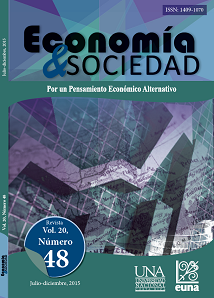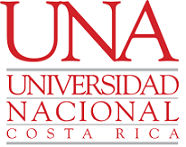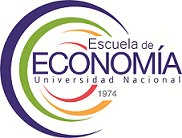¿Cuáles son las condiciones que generan el éxito micro-financiero?
DOI:
https://doi.org/10.15359/eys.20-48.4Palabras clave:
Determinantes del desarrollo, desarrollo humano, microcréditos, pobrezaResumen
En este trabajo nos aproximaremos al estudio de las causas del desarrollo desde aquellos elementos que hacen de la micro-financiación una herramienta efectiva en la erradicación de la pobreza. La eficacia de tal instrumento en la generación de riqueza a las clases más empobrecidas exige superar el marco minimalista de actuación que condena sus prácticas a la mera provisión de servicios microfinancieros. Esta proposición será corroborada analítica y empíricamente desde la asimilación del desarrollo humano como causa y no solo resultado del éxito microfinanciero. Para ello diseñamos dos rectas de regresión donde variables como la educación, sanidad y seguridad alimentaria mostrarán ser determinantes a la hora de explicar el comportamiento en los ingresos de los beneficiarios de tales programas microfinancieros.
Referencias
Acemoglu, D., & Robinson, J. (2012). Why Nations Fail. The Origins of Power, Prosperity and Poverty. Retrieved from https://books.google.co.cr/books?id=yIV_NMDDIvYC&redir_esc=y
Aghion, B., & Morduch, J. (2003). The Economics of Microfinance. Cambridge: the MIT Press.
Arcand, J. & Faye, I. (2002). Health and Economic Growth: Findings and Policy Implications. Retrieved from http://www.upf.edu/pdi/cres/lopez_casasnovas/_pdf/health_economic.pdf
Banerjee, A., Vinayak, A., & Duflo, E. (2011). Poor Economics: A Radical Rethinking of the Way to Fight Global Poverty. Retrieved from https://books.google.co.cr/books?id=Tj0TF0IHIyAC&redir_esc=y
Besley, T. & Coate, S. (1993). The Economics of rotating savings and credit associations.American Economic Review, 3(83), 792-810.
Bruhn, E., & Love, I. (2009). The Economic Impact of Banking the Unbanked.Evidence from Mexico.http://dx.doi.org/10.1596/1813-9450-4981
Cohen, M. & Nelson, C. (2011). Financial literacy: A step for clients towards financial inclusion (Commissioned Workshop Paper). Retrieved from http://citeseerx.ist.psu.edu/viewdoc/download?doi=10.1.1.466.2029&rep=rep1&type=pdf
De la Cruz, N., Crookston, B., Gray, B., Alder,S., &Dearden, K. (2009). Microfinance against malaria: impact of Freedom from Hunger’s malaria education when delivered by rural banks in Ghana. Transactions of the Royal Society of Tropical Medicine and Hygiene, 103(12), 1229-1236. http://dx.doi.org/10.1016/j.trstmh.2009.03.018
Devoto, F., Duflo, E., Dupas, V., & Pouliquen, V. (2011). Turning a Shove into a Nudge? A Labeled Cash Transfer for Education (Working Paper No.19227) Retrieved from web site of The National Bureau of Economic Research: http://www.nber.org/papers/w19227
Field, E. & Pande, R., (2007). Repayment Frequency and Default in Micro-Finance: Evidence from India. Retrieved from http://www.hks.harvard.edu/fs/rpande/papers/repayfreqjeea_1107.pdf
Fisher, T. & Sriram, M., (2002). Beyond micro-credit: Putting development back into micro-finance. Retrieved from https://books.google.co.cr/books/about/Beyond_Micro_credit.html?id=jfBnBtxmPUwC&redir_esc=y
Gallup, J. & Sachs, J. (2001). The Intolerable Burden of Malaria: A new look at the numbers. The American Journal of Tropical Medicine and Hygiene, 64(1). Retrieved fromhttp://www.ncbi.nlm.nih.gov/books/NBK2624/
Ghatak, M. & Guinnance, T. (1999). The Economics of lending with joint-liability: theory and practice. Journal of Development Economics, 60(1), 195-228. http://dx.doi.org/10.1016/S0304-3878(99)00041-3
Giné, X. & Karlan, D. (2007). Group versus Individual Liability: A Field Experiment in the Philippines. Retrieved from http://www-wds.worldbank.org/external/default/WDSContentServer/WDSP/IB/2006/09/18/000112742_20060918174212/Rendered/PDF/WPS40081IE70B3111130ADDITIONAL0COTITL.pdf
Jimenez, A. (2013). Economía del desarrollo humano y microfinanciacion. Una aproximación a los determinantes del Microcrédito. (Tesis doctoral inédita, Universidad de Sevilla).Retrievedfromhttp://fondosdigitales.us.es/tesis/tesis/2078/economia-del-desarrollo-humano-y-microfinanciacion-una-aproximacion-los-determinantes-de-microcredito/
Karlan, D., & Zinman, J. (2009). Expanding Microenterprise Credit Access: Randomized supply decisions to estimate impacts in Manila (Economic Department Working Paper, Nº68). Yale University. Retrieved from web site Department of Economics Yale University: http://economics.yale.edu/sites/default/files/files/Working-Papers/wp000/ddp0068.pdf
Karlan, D., & Valdivia, M. (2011). Teaching Entrepreneurship: Impact of Business Training on Microfinance Clients and Institutions.The Review of Economics and Statitics, 93(2), 510-527.http://dx.doi.org/10.1162/REST_a_00074
Khandker, S. (1998). Does Microfinance really benefit the poor? Evidence from Bangladesh, paper delivered at Asia and Pacific Forum on Poverty: Reforming policies and institutions for poverty reduction.Held by the Asian Development Bank. Retrieved from http://pdf.wri.org/ref/morduch_02_analysis_effects.pdf
Landes, D. (1999). The Wealth and Poverty of Nations. Why are some so rich and some so poor. Retrieved from https://books.google.co.cr/books/about/The_Wealth_and_Poverty_of_Nations_Why_So.html?id=A6JPn5zAR1AC&redir_esc=y
Leatherman, S., Dunford, C.,Metcalf, M.,&Reinsch, M.(2011).Integrating Microfinance and Health.Benefits, Challenges and Reflections for moving forward. Retrieved from http://www.microcreditsummit.org/resource/38/integrating-microfinance-and-health-benefits.html
Leive, A. & Xu, K. (2008). Coping with Out-of-Pocket Health Payments: Empirical Evidence from 15 African Countries.Bulletin of the World Health Organization, 86(11), 849-56. Retrieved from http://www.who.int/bulletin/volumes/86/11/07-049403.pdf
Maniruzzama, M. & Rutherford, S. (1998). Exploring Client Preferences in Microfinance.The Consultative Group to Assist the Poorest.
McIntosh, C. & Wydick, B. (2002). Competition and Microfinance.Working Paper, Berkeley, University of San Francisco.Retrieved form http://repository.usfca.edu/cgi/viewcontent.cgi?article=1019&context=econ
MkNelly, B., &Dunford, C. (1998). Impact of credit with education on mothers and their Young children´s Nutrition: Lower Rural Bank Credit with Education Program in Ghana. (Research Paper No.4). Retrieved from web site Freedom from Hunger: https://www.freedomfromhunger.org/impact-credit-education-mothers-and-their-young-children%E2%80%99s-nutrition-lower-pra-rural-bank
Montgomery, H. (2005). Serving the Poorest of the poor: The poverty impact of the Khushhali Bank´s Microfinance Lending in Pakistan.Retrieved fromhttp://www.adb.org/publications/serving-poorest-poor-poverty-impact-khushhali-banks-microfinance-lending-pakistan
Nanor, M. (2008). Microfinance and its impact on selected districts in Eastern Region of Ghana.Final Dissertation. Retrieved fromhttp://ir.knust.edu.gh/handle/123456789/598
Nelson, L. (2011). From Loans to Labour: Access to Credit, Entrepreneurship and Child Labour. Mimeo. Retrieved from http://www.colorado.edu/Economics/seminars/SeminarArchive/2011-12/Nelson.pdf
United Nations Development Programme (1994). Human Development Report 1994.Retrieved fromhttp://hdr.undp.org/en/content/human-development-report-1994
United Nations Development Program (2012). Concept and measurement of Human Development 2012.Retrieved from http://hdr.undp.org/en/reports/global/2000?page=1
Robinson, M. (2004). La Revolución Microfinanciera. Finanzas sostenibles para los pobres.Retrieved fromhttp://www-wds.worldbank.org/external/default/WDSContentServer/WDSP/IB/2007/05/11/000020953_20070511133803/Rendered/PDF/232500v10SPANI1180015721X001PUBLIC1.pdf
Rogers, H., & Stern, N. (2005). Growth and Empowerment: Making Development Happen. Retrievedfromhttps://mitpress.mit.edu/books/growth-and-empowerment
Sadoulet, L. (2003). The role of mutual insurance in group lending.Draft, ECARES, Free University.Retrived from http://www.researchgate.net/publication/247985788_The_Role_of_Mutual_Insurance_in_Group_Lending
Smith, A. (2007). An Inquiry into the Nature and Causes of the Wealth of Nations. Retrieved from http://www.ibiblio.org/ml/libri/s/SmithA_WealthNations_p.pdf
Todd, H. (1996). Women at the center: Grammer Bank borrowers after one decade. Retrieved from http://uplbooks.com.bd/book/women-center-grameen-bank-borrowers-after-one-decade
Yunus, M. (2001). Banker of the Poor: The Autobiography of Muhammad Yunnus, Founder of the Grammer Bank. Retrieved from http://www.amazon.com/Banker-Poor-Autobiography-Muhammad-Founder/dp/0195795377
Yunus, M. (2010). Building Social Business. The New Kind of Capitalism that serve humanity´s most pressing needs. Retrieved from https://books.google.co.cr/books?id=W0EDHD28NB8C&redir_esc=y
Publicado
Cómo citar
Número
Sección
Licencia
Esta publicación está adscrita a Creative Commons; deben respetarse sus atribuciones y restricciones.
Los autores/as que publiquen en esta revista aceptan las siguientes condiciones:
- Los autores/as conservan los derechos de autor y ceden a la revista el derecho de la primera publicación, con el trabajo registrado con la Licencia Creative Commons Atribución-NoComercial-CompartirIgual 4.0 Internacional, que permite a terceros utilizar lo publicado siempre que mencionen la autoría del trabajo y a la primera publicación en esta revista.
- Los autores/as pueden realizar otros acuerdos contractuales independientes y adicionales para la distribución no exclusiva de la versión del artículo publicado en esta revista (p. ej., incluirlo en un repositorio institucional o publicarlo en un libro) siempre que indiquen claramente que el trabajo se publicó por primera vez en esta revista.
- Se permite y recomienda a los autores/as a publicar su trabajo en Internet (por ejemplo en páginas institucionales o personales) antes y durante el proceso de revisión y publicación, ya que puede conducir a intercambios productivos y a una mayor y más rápida difusión del trabajo publicado.

Revista Economía y Sociedad by Universidad Nacional is licensed under a Creative Commons Reconocimiento-NoComercial-CompartirIgual 4.0 Internacional License.
Creado a partir de la obra en http://www.revistas.una.ac.cr/index.php/economia









